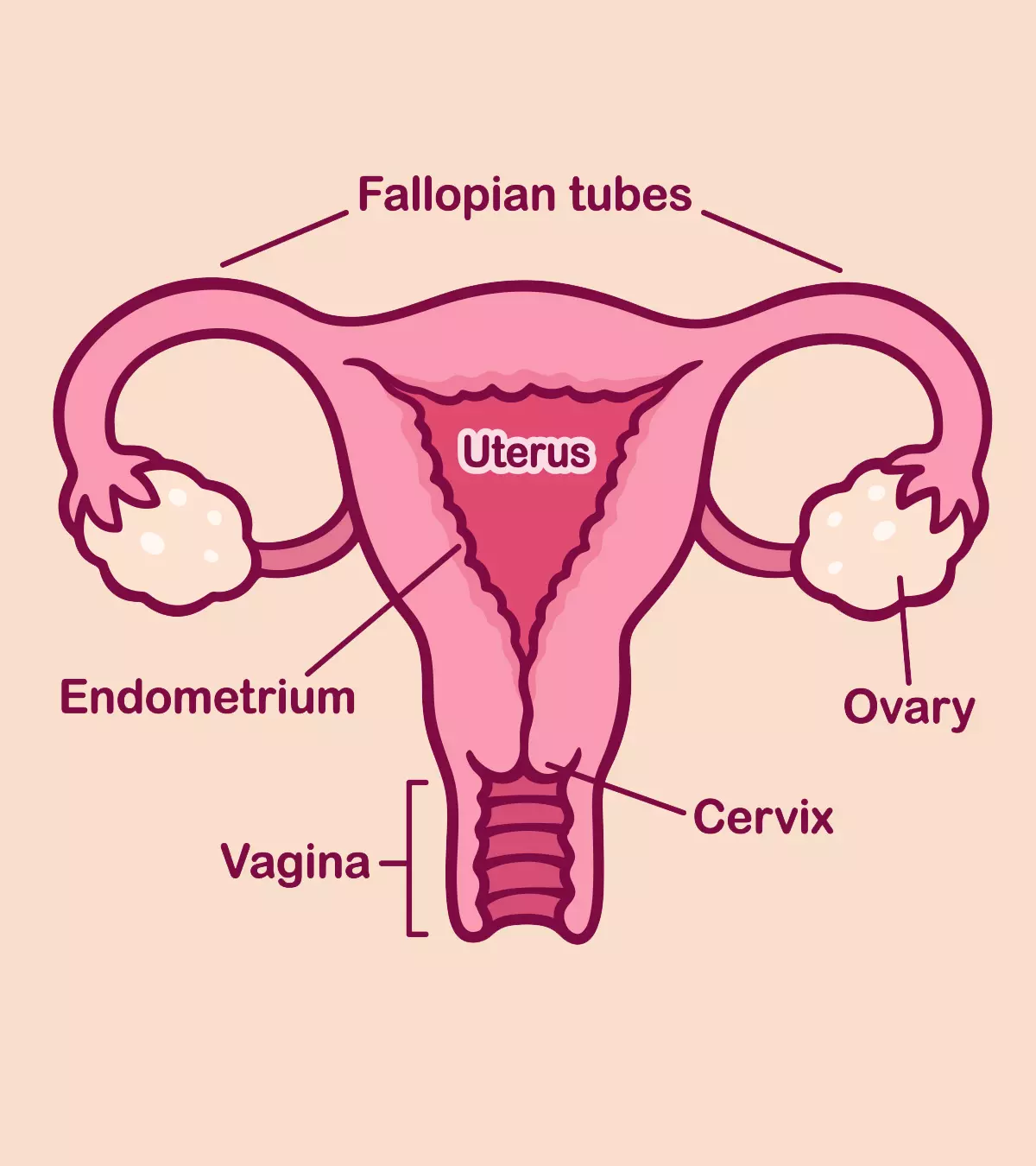
Image: ShutterStock
The cervix plays a key role in pregnancy and childbirth. Changes in cervical mucus and cervical position in early pregnancy may help know that you are conceiving before the tests turn positive. Women aware of cervical positions in ovulation can easily identify these changes. Usually, the cervix position can be high during ovulation and low during menstruation. Cervix may remain in a high position if you are pregnant. However, not all women can accurately understand these changes.
Read on to know more about cervical positions, how does your cervix feel in early pregnancy, and how reliable it is to confirm pregnancy.
Key Pointers
- The cervix’s position and the cervical mucus’s consistency change during early pregnancy to ensure safe sustenance of pregnancy.
- Accurately understanding these changes may help a woman know when pregnant even before confirming the same with the tests.
The Cervix And Its Role
The cervix is the narrow, lower part of the uterus and connects the uterus with the vagina. It is around 3 to 4cm in length. The lining layer of the cervix contains glands which produce hormone dependent mucus. During ovulation, the mucus becomes thinner, allowing the passage of sperms to the egg. Once you are pregnant, the mucus becomes thicker again to protect the uterus from harmful bacteria (1). In early pregnancy, changes take place in the position and texture of the cervix as well as in the consistency and color of cervical discharge.
A shortened cervical length has been identified as one of the significant risk factors for preterm birth. Therefore, knowing the cervical length is important to reduce any risk of preterm birth. The graph below represents the average cervical length in different gestational ages of women at risk of preterm delivery. The graph shows a general decline in cervical length from the second trimester at 22 weeks.

Median cervical length throughout pregnancy
Source: Spontaneous preterm birth and cervical length in a pregnant Asian population; PLOS ONEKeep reading to know how the cervical position changes during ovulation and early pregnancy.
Cervical Position During Ovulation
As the ovulation date approaches, the cervix remains high inside the vagina to facilitate conception (2). During ovulation, the cervix softens and opens slightly, giving the sperm access to the uterus. After ovulation, the cervix becomes firm, the uterus opening gets closed with mucus, and the cervix drops down and remains shut until the next period. Along with changes in the cervix, you may also experience symptoms like increased libido, tender breasts, slight pain in the abdomen or pelvic area, bloating, and even spotting (3). These signs can help you recognize your fertile window as you’re ovulating.
Dr. Alan R. Lindemann, MD, MS, an obstetrician and a former clinical associate professor at the University of North Dakota, says, “Although a soft, blue, and high cervix often indicates pregnancy, it can also be associated with the hormones of estradiol at midcycle, around the time of ovulation.
“During your period, the cervix is not soft because the hormones (estradiol) that make your cervix soft and high are decreasing. Your cervix will dilate to help let out the blood from the uterus. It is normal for your cervix to be low, hard, and dilated a little. Your cervix will come down, be firm, and slightly dilated a day or two before you have a normal period.”
 Did you know?
Did you know?Cervical Position In Early Pregnancy
Dr. Lindemann observes, “Your cervix becomes high, soft, and blue in early pregnancy. Your vagina and vulva also turn blue due to venous engorgement from hormones (estradiol, the main estrogen in your body). These changes of blue discoloration and engorgement are called Chadwick’s sign.”
When you conceive, the cervix will close with a thick mucus plug to protect the pregnancy (4). The cervix feels soft early in pregnancy due to the increased blood flow in the area caused by hormonal changes.
You can try and test for pregnancy by gauging the cervical position. Keep reading to know how.
How To Check For Pregnancy With The Cervical Position?
You can check the cervical position for pregnancy by inserting your finger into the vagina. But before you do, make sure you:
- Clean your hands properly to reduce the chances of infection.
- Cut your fingernails.
- Get into a squatting position.
Once you are in the squatting position, insert the longest finger inside the vagina. You can feel a firm, rounded, lip-like structure that sticks out into the vagina, which is the outer part of the cervix (1).
- Slide your finger upward – if the cervix feels high up and soft with a slight opening, it means you are ovulating.
- If you feel the cervix lying low, hard, and closed, then it indicates that either you have not ovulated or the ovulation has already occurred.
It is not easy to determine the cervical position in the first go. You need to practice it every day: feel the cervical position and note down the changes. Also, consider checking your cervix at the same time every day, preferably first thing in the morning when your bladder is full, for more accurate results.
Changes in the cervical position are also associated with changes in the cervical mucus in early pregnancy. Next, we tell you about the role of the cervical mucus in determining the position of the cervix.
Texture
Pregnancy increases blood flow to the cervix. If the woman has not conceived, the cervix is presented firm to the touch, like the tip of a nose, but if conception has been achieved the cervix is softer resembling the lips.
Cervical changes may be subtle and many women may not understand these changes as pregnancy signs.
According to Dr. Cindy M. Duke, MD, Ph.D. FACOG, a board-certified obstetrician/gynecologist and fertility specialist from Las Vegas Metropolitan Area, “A soft cervix usually indicates pregnancy, as it is one of the first things to occur when you conceive. Though it does not always mean that you’ve conceived, it can also be something you’re born with because of certain medications and a decrease in muscle tone.”
 Quick fact
Quick factHow To Check For Changes In Cervical Position With Cervical Mucus?
If you want to ascertain the pregnancy with the changing cervical position, you must also pay attention to the cervical mucus. The mucus changes with the approaching ovulation and helps you determine the fertile time.
After the period, women observe reduced discharge or mild vaginal dryness. A few days later, but before ovulation, discharge becomes sticky and may appear white or yellow. In fertile window, but before ovulation, discharge increases and becomes creamy and opaque. At ovulation the mucus will be stretchy and looks like egg white. After ovulation if the woman has conceived, the mucus increases but if pregnancy has not been achieved, the mucus will begin to dry up and thicken (5).
 Quick fact
Quick factIs It A Reliable Pregnancy Test?
No, because the cervical position can vary with different body positions. For example, the cervix’s position before sexual intercourse is not the same as immediately after, which could lead to misjudgment. Also, the changes in the cervical position follow a pattern, which you can understand only by tracking it for a few cycles.
Frequently Asked Questions
1. How should the cervix feel before a period?
The cervix may feel firm, and the cervical mucus thickens before the onset of the menstrual cycle (7).
2. How soon does the cervix change in early pregnancy?
Although it depends significantly on a woman’s reproductive health status and medical history, the alterations in the cervical length are usually detected in the first trimester, anywhere between 11 to 24 weeks (8).
Knowing the cervical position in early pregnancy may help ascertain conception before using a home pregnancy kit to confirm the result. The cervix usually feels softer on conceiving, moves higher up, and is plugged with mucus for protection. However, the cervical position may vary from one woman to another, and making a correct prediction may not be easy. You need proper practice to understand the changes and patterns of the cervix’ positions for accurate interpretation. Follow proper hygiene measures before performing a cervical examination to assess cervical changes. Concomitant use of fertility tracking methods such as basal body temperature and the cervical position may be helpful. Nevertheless, the only guaranteed method to check for pregnancy is with a pregnancy test. It is advisable to consult a gynecologist in order to determine the most appropriate timing and method for taking the test, ensuring proper prenatal care.
Infographic: Cervical Changes In Pregnancy And Menstrual Cycle
The position of the cervix changes during the monthly cycle and it can indicate if you are pregnant. How to learn about pregnancy through cervical changes? The below infographic provides you with practical ways for checking:
- Cervical position in pregnancy
- Changes in cervical mucus

Illustration: Momjunction Design Team
References
1. The cervix; Canadian Cancer Society
2. Fiona McCulloch; 8 Steps to Reverse Your PCOS: A Proven Program to Reset Your Hormones
3. Ovulation; Cleveland Clinic
4. Cervical Effacement and Dilatation; Regents of the University of Michigan
5. What’s the cervical mucus method of FAMs?; Planned Parenthood Federation of America Inc.
6. Anatomy of pregnancy and birth – cervix; Pregnancy Birth and Baby
7. Cervical Mucus; Cleveland Clinic
8. Athena P Souka et al., (2011);Cervical length changes from the first to second trimester of pregnancy, and prediction of preterm birth by first-trimester sonographic cervical measurement; NCBI.
Community Experiences
Join the conversation and become a part of our nurturing community! Share your stories, experiences, and insights to connect with fellow parents.
Read full bio of Dr. Irene (Eirini) Orfanoudaki
- Dr. Alan Lindemann is an obstetrician and maternal mortality expert, who worked as a clinical associate professor at the University of ND. An alumnus of the University of ND and the University of Minnesota, he is a member of the American College of Obstetricians and Gynecologists and the American Medical Association.
 Dr. Alan Lindemann is an obstetrician and maternal mortality expert, who worked as a clinical associate professor at the University of ND. An alumnus of the University of ND and the University of Minnesota, he is a member of the American College of Obstetricians and Gynecologists and the American Medical Association.
Dr. Alan Lindemann is an obstetrician and maternal mortality expert, who worked as a clinical associate professor at the University of ND. An alumnus of the University of ND and the University of Minnesota, he is a member of the American College of Obstetricians and Gynecologists and the American Medical Association.
Read full bio of shreeja pillai
Read full bio of Rebecca Malachi
Read full bio of Reshmi Das





















